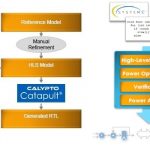You are currently viewing SemiWiki as a guest which gives you limited access to the site. To view blog comments and experience other SemiWiki features you must be a registered member. Registration is fast, simple, and absolutely free so please,
join our community today!
High-Level Synthesis (HLS) is design flow in which design intent is described at a higher level of abstraction such as SystemC/C++/Matlab/etc. HLS tools are expected to synthesize this code to RTL which can be input to the traditional RTL downstream flow (RTL/GDS).
Formal check tools are difficult to be analyzed on generated
…
Read More
As SoC complexities continue to expand to billions of transistors, the quest for higher levels of design automation also rises. This has led to the adoption of High-Level Synthesis (HLS), using design languages such as C++ and SystemC, which is more productive than traditional RTL design entry methods. In the RTL approach there… Read More
I first heard about High Level Synthesis (HLS) while working in EDA at Viewlogic back in the 1990s, and have kept watch on the trends over the past decades. Earlier this year Siemens EDA hosted a two day event, having speakers from well-known companies share their experiences about using HLS and High Level Verification (HLV) in their… Read More
Imagine how semiconductor design sizes leapt higher with automation in digital design, which started from standard hardware languages like Verilog and VHDL; analog design automation is still catching up. However, it was not without a significant effort put in moving designers from entering schematics to writing RTL, which… Read More




